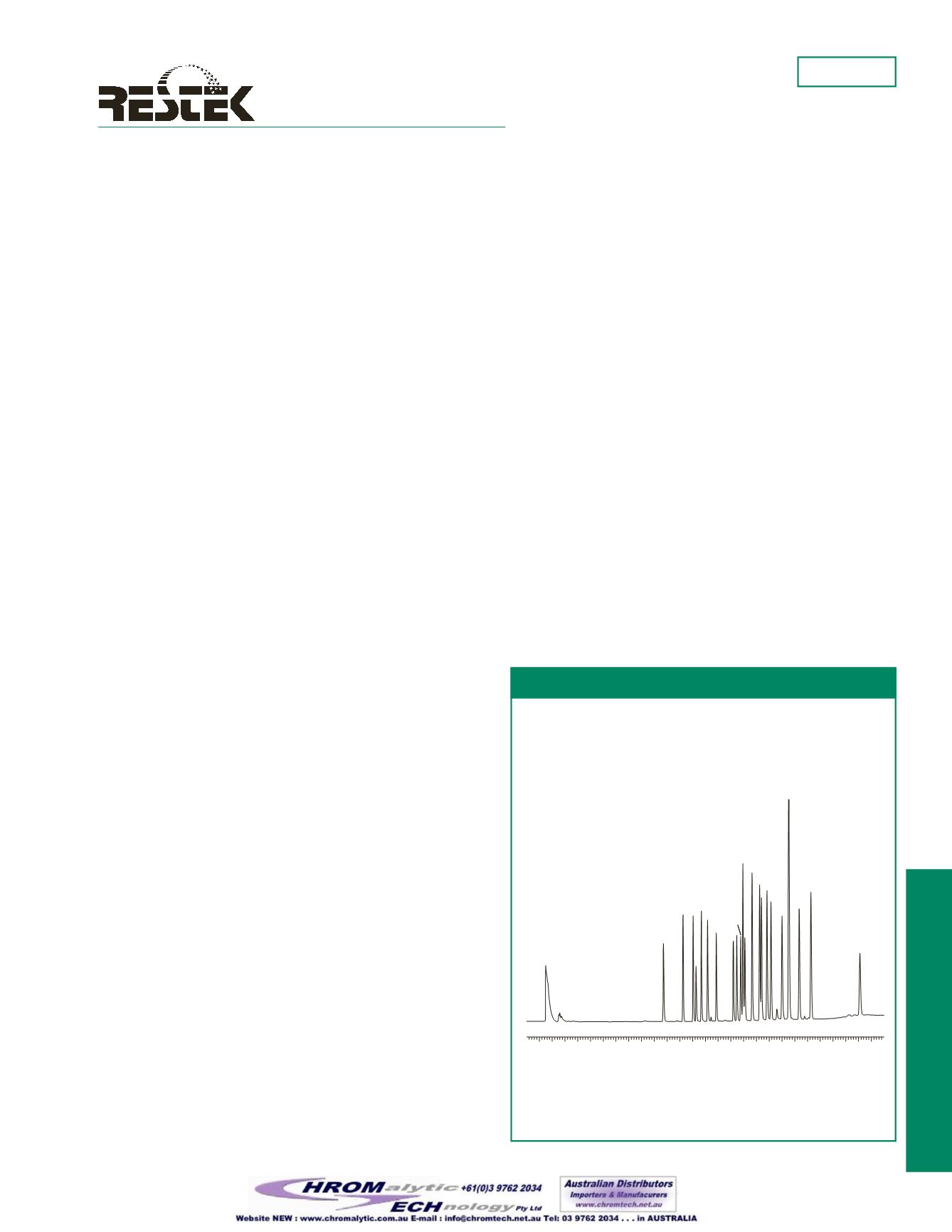
environmental
Applications
note
Restek Corporation • (800) 356-1688 • (814) 353-1300 •
#59351B
environmental
Stx
™
-CLPesticides andStx
™
-CLPesticides2Columns Provide Improved
System Inertness for ChlorinatedPesticidesAnalysis
Many laboratories performing gas chromatography (GC) analy-
sis of chlorinated pesticides strugglewith endrin breakdown
caused by the compound interactingwith or adsorbing to active
sites throughout the analytical system, most notably in the injec-
tion port and the analytical column. Restek Siltek
™
technolo-
gy—used successfully to passivate injection port liners and
guard columns—is now available for column technology and is
used in Stx
™
-CLPesticides and Stx
™
-CLPesticides2 capillary
columns. The combination of a properly deactivated injection
system and inert analytical columns provides the lowest possi-
ble level of endrin breakdown.
MethodRequirements
Chlorinated pesticide analysis followingUSEnvironmental
ProtectionAgency (EPA)Methods 8081, 608, 505 and 508 rec-
ommend dual-column confirmation using electron capture
detection (ECD). The compounds in Figure 1 represent some of
themore common analytes.As in all analytical methods, the
instrument used for quantitative analysismust be calibrated to
ensure accurate results are reported. For chlorinated pesticides
this usually entails a calibration curve of three to five points and
check standards injected at specified time intervals during sam-
ple analysis. In addition, performance standards containing
endrin are analyzed periodically to ensure system inertness.
Typically, endrin breaks down to endrin aldehyde and endrin
ketonewhen there are active sites in the sample pathway.
EndrinBreakdown
Maintaining a low breakdown level for endrin is necessary for
laboratories analyzing chlorinated pesticides. Reduction of
endrin breakdown generally focuses on improving the inertness
of the injection port. Traditionally, deactivated injection port
liners have been used for this analysis but, more recently, liners
treatedwith Siltek
™
passivation have been proven to further
reduce endrin breakdown. This innovative passivation technolo-
gy alsowas incorporated into capillary guard tubing so that the
entire sample introduction pathway is inert for pesticide analysis.
EndrinResponse onCapillaryColumns
Through experimentationwe have found that the columns typi-
cally used for pesticide analysis exhibit low response for endrin
compared to other pesticides eluting in the same region even
though the endrin breakdown products are not present. This
indicates that endrin is being adsorbed by active sites in the
sample pathway, thus effectively reducing endrin response. To
minimize the on-column adsorption of endrin, we incorporated
Siltek
™
passivation technology into the analytical columns.
30m, 0.32mm ID, 0.50µmStx-CLPesticides (cat# 11544)
Oven temp.:
120°C (hold 1min.) to 300°C@ 9°c/min.;
Det.:
310°C, Agilent ECD;
Inj.:
1µL, pesticide standardmix A and B (cat.#32003,32004, 20/40/200ng/mL);
Inj. temp.:
220°C (splitless, 1min. purge off hold);
Inlet liner:
4mmSiltek
™
single
gooseneck (cat.# 20798-214.1);
Dead time:
0.9min. @ 120°C.
1. 2,4,5,6 -tetrachloro-
m
-xylene (ss)
2.
a
-BHC
3.
g
-BHC
4.
b
-BHC
5.
d
-BHC
6. heptachlor
7. aldrin
8. heptachlor epoxide
9.
g
-chlordane
10.
a
-chlordane
11. 4,4'-DDE
12. endosulfan I
13. dieldrin
14. endrin
15. 4,4'-DDD
16. endosulfan II
17. 4,4'-DDT
18. endrin aldehyde
19. methoxychlor
20. endosulfan sulfate
Combining Siltek
™
passivationwith the unique selectivity of
RestekCLPesticides phases results in the Stx
™
-CLPesticides
and Stx
™
-CLPesticides2 columns, and a significant improvement
in endrin response (Figures 1& 2). Using the Stx
™
-CLPesticides
and Stx
™
-CLPesticides2 columns, the endrin peak response is
notably higher than the analytes eluting in the same region—
something not always seen in columns using traditional deactiva-
tions.
Column Installation andOptimizingResolution
The Stx
™
-CLPesticides2 column is the ideal confirmational col-
umn to the Stx
™
-CLPesticides column. Theywere designed to
achieve resolution of the chlorinated pesticides using the same
backpressure and oven temperature program. The columns can
be installed in parallel using a glass universal Press-Tight
®
“Y”
connector or ametalMXT
®
“Y” connector (Figure 3). This par-
allel set-up reduces downtime caused bymaintenance ofmulti-
ple injection ports. Of course, these columns can also be
installed in separate injection ports andmounted in the same
GC oven.
The Stx
®
-CLPesticides column provides the ultimate in inertness
for active pesticides such as endrin, DDT, andmethoxychlor.
Figure 1
21. endrin ketone
22. decachlorobiphenyl (ss)
7
8
5
6 3
4
1
2
15
16
13
14
11
12 9
10
21
22
19
20
17
18
min.
1
2
3
4
5
6
7
8
9
10
11
12
13
GC_EV00511


